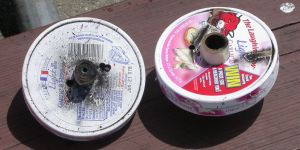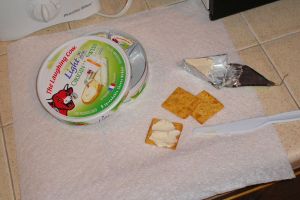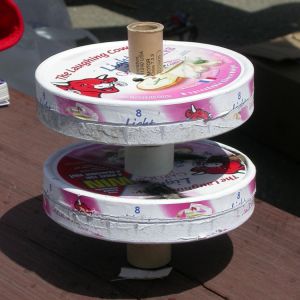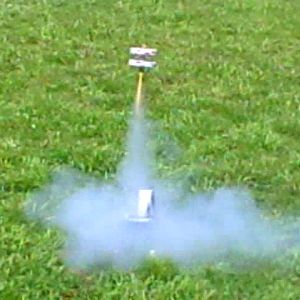Scratch Cheese Wheel Original Design / Scratch Built
Scratch - Cheese Wheel {Scratch}
Contributed by Matt Wedel
| Manufacturer: | Scratch |

Brief:
This is a blatant rip-off of
Art Applewhite's
Serve-N-Store Saucer using a cardboard cheese container.
Construction:
Here's a list of the materials you will need to build and fly the Cheese Wheel:

- One round cardboard cheese container. I use the Laughing Cow brand, which comes in a 4 3/8" diameter box that is 7/8" tall. Available brands and sizes may vary by region.
- 18mm or 24mm motor casing
- Pen or pencil
- Hobby knife
- Hole punch
- Glue
- Masking tape
Construction is essentially the same as for the Serve-N-Store Saucer, but was slightly simplified because the cheese box has no outer flange to cut off. The cheese box naturally separates into two halves, a lid and a base. After you've eaten all the cheese (I recommend eating it with pepperoni on saltines), stand your motor casing in the center of the base and trace its outline. The dimensions are small enough and the design is robust enough that simply eyeballing the center is fine. Cut out the hole for the motor. Now use the hole punch to put a small hole 1/4" to 1/2" away from the hole for the motor. This will serve as a launch lug. Once you have both holes in the base, set it on top of the lid and use it as a template to trace identical holes onto the lid. Cut the holes in the lid using a hobby knife for the motor hole and a hole punch for the launch lug hole.
 Now you're ready to glue it together. The box is actually made of three separate pieces of
cardboard: the lid, the base, and a ring inside the base that actually butts up against the cheese wedges. The inner
ring is usually loose, so it's a good idea to run a bead of glue around the inside of the base to tack it down. Test
fit the lid on the base to make sure everything still fits and try to get the launch lug holes lined up ahead of time.
The inner ring of the base forms a shoulder that fits up inside the lid. I prefer to put the glue inside the lid rather
than on the shoulder of the base because it is less likely to ooze out that way. Once you have the glue on, put the lid
on the base and rotate it so that the launch lug holes are lined up.
Now you're ready to glue it together. The box is actually made of three separate pieces of
cardboard: the lid, the base, and a ring inside the base that actually butts up against the cheese wedges. The inner
ring is usually loose, so it's a good idea to run a bead of glue around the inside of the base to tack it down. Test
fit the lid on the base to make sure everything still fits and try to get the launch lug holes lined up ahead of time.
The inner ring of the base forms a shoulder that fits up inside the lid. I prefer to put the glue inside the lid rather
than on the shoulder of the base because it is less likely to ooze out that way. Once you have the glue on, put the lid
on the base and rotate it so that the launch lug holes are lined up.
PROs: Cheap, easy, and fast.
CONs: Not challenging at all.
Finishing:
The Cheese Wheel is made of cardboard with paper labels on the top, bottom, and sides. It could be stripped and
painted, covered, painted, and so on, but I chose to leave mine naked. You get more laughs at the flight line that way.
PROs: Nothing to do unless you want to. The naked rocket has some novelty value.
CONs: Ugly.

Flight:
The motor stands in the middle of the wheel. Wrap a few turns of masking tape around the base of the motor to make a
thrust ring. I also like to put a few turns around the top of the motor to ensure that it stays with the saucer on the
way down. The motor is unlikely to come free but if it did it would be a real pain to find. Once the motor is
installed, put in an igniter as you would normally, slide the launch lug holes over the launch rod, clip it up, and
you're ready to launch.
I have built the Cheese Wheel in 18mm and 24mm versions. The only detectable difference in performance is that the 18mm version tops out at under 200 feet and the 24mm version will go a little higher. In all of my flights the boost has been straight. The saucer may wobble rapidly from side to side but these wobbles don't amount to anything. The Cheese Wheel is stable but poorly dampened, and any slight asymmetry in the position of the holes or the alignment of the motor will cause it to spin. Assuming you use motors with ejection charges, ejection happens harmlessly at apogee.
It is easy to stack two Cheese Wheels for CHAD staging with a 24mm booster going to an 18mm sustainer. To prep this, I friction fit the 18mm motor inside the 24mm motor. Then wrap tape around the exposed bottom of the 18mm motor to make a thrust ring and wrap more tape around the top of the 24mm motor to make a retainer. Then I slid the Cheese Wheels onto the motor--the 18mm Wheel goes down onto its motor and the 24mm wheel goes up onto its motor. Then add more tape to both motors to make a thrust ring on the 24mm motor and a retainer on the 18mm motor and you're all set.
You can launch the Cheese Wheel on any size motor you want, but on As and Bs it doesn't really go anywhere. I recommend flying the 18mm version on C6s. I have only used D12s on the 24mm version.
Staged flights have the same characteristics as unstaged flights, they just go higher. If anything, the staged Cheese Wheels wobble a little less than the solo fliers. The only real downside of staging is that both rockets may get a little scorched when the sustainer lights. The damage is merely cosmetic. I think it looks cool, but if you want to protect the finish of your rocket you should either avoid staging or find some way to protect the facing surfaces of the stacked saucers. I have also used the 24mm Cheese Wheel as a booster for a more conventional 18mm 3FNC, with good results.
I have flown the Cheese Wheel on fairly windy days and it has not weathercocked at all nor is the boost deflected downwind. It's a straight boost every time, solo or staged.
PROs: Very straight and stable boosts. Hard to imagine what could possibly go wrong (famous last words...)
CONs: Low and slow. CHAD staging may scorch both rockets.
Recovery:
After ejection, the rocket tumbles back to earth. In contrast to many other saucers it does not usually come down as
an aeroshell. Rather, it flips rapidly end over end like a coin flipped into the air. If there is any wind, it can
"fly" surprisingly far this way. In a steady 10mph breeze it may land a couple of hundred feet from the pad.
And it pays to watch it all the way down. The saucer is so small that it is pretty easy to lose in grass of almost any
height. I've never lost one for good yet, but I've had some that took me 15 minutes or more to find, which seems
ridiculous for a rocket that will never break 300 feet.
PROs: Nothing to do. Rocket is apparently indestructible. Comes down gently.
CONSs: Rocket can drift a surprising distance on the way down. Can be tough to spot in grass.
Summary:
This is a fun, quick and easy build that will probably get you some laughs on the flight line. Impressive and
satisfying flights. Just try not to get frustrated chasing it down or trying to find it in the grass.
Sponsored Ads
 |
 |











